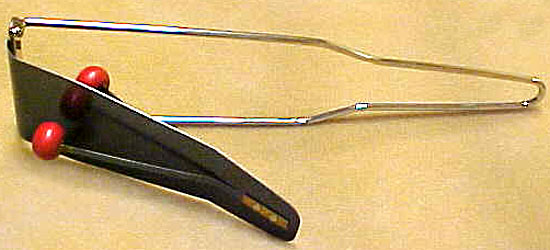flex-a-tone
[English]
HISTORY: A 1920s percussion instrument invented in England that provides a unique sound that is used for comic effect. It can occasionally be heard in films or cartoons often for a spooky or funny sound.
There are a few classical composers that have used the flex-a-tone including, Arnold Schoenberg, Aram Khachaturian, Ernst Krenek, Dmitri Shostakovich, and György Ligeti. There are also occasional uses in concert band compositions.
PHYSICAL DESCRIPTION: This friction idiophone consists of of wooden balls on a spring attached to a flexible metal sheet with a wire frame. The flex-a-tone is held in one hand with the palm around the wire frame and the thumb on the free end of the metal sheet. When the instrument is shaken, the balls strike the metal sheet producing a sound similar to a musical saw. When the thumb depresses the vibrating metal sheet, the pitch of the instrument changes.
SOUND PROPERTIES: This instrument makes a unique sound similar to a musical saw starting with a low pitch at first, and a higher pitch as the thumb depresses the metal sheet. As the thumb pressure is released, the pitch will again get lower. This procedure produces a glissando effect from low pitch to high pitch and back. The size of the metal sheet determines the exact pitches that are possible. The instrument can also be performed without the wooden balls. The metal sheet can be struck with other objects which will change the sound of the instrument as the metal sheet is depressed and released.
RANGE: The flex-a-tone does have discernible pitches, however, it is extremely difficult to control the instrument well enough to sound exact pitches. Since, there is no specific size for this instrument, there is no common range of pitches associated with it.
When composing for the flex-a-tone, the composer simply designates the beginning of the sound with a wavy line either upwards or downwards to designate the higher or lower pitches along with the duration of the desired sound.
Example

See Also
[French] flexatone (m)[German] Flexaton (n)
[Italian] flessatono (m)
Share
Tweet
Last Updated: 2016-05-25 13:35:31

